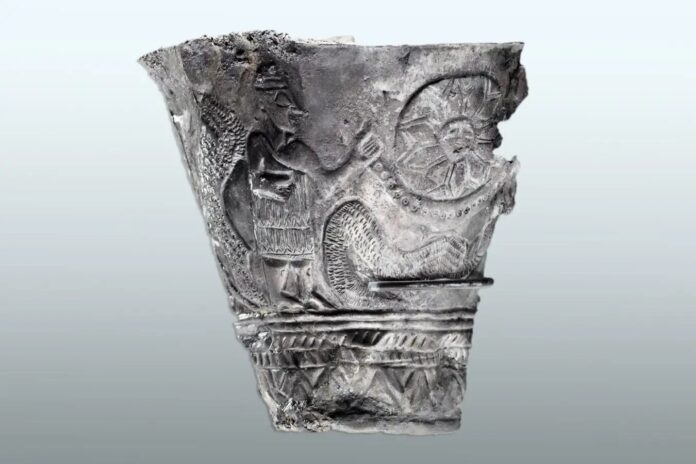A stunningly preserved silver goblet unearthed in the Palestinian West Bank over half a century ago is rewriting our understanding of early cosmological beliefs. Dating back 4,300 years, this intricate artifact may depict the universe birthing from primordial chaos, potentially making it the oldest known visual representation of a creation myth.
The ˁAin Samiya goblet, standing just under 3 inches tall, was discovered in an ancient tomb near Ramallah – a region historically known as the Fertile Crescent, a cradle of early civilizations. Its surface is adorned with two distinct scenes etched into its silver.
In the first scene, a colossal serpent confronts a chimera—a creature with a human torso and animal legs—which towers over a small flower-like emblem. This unsettling image may represent chaos reigning supreme. In contrast, the second scene presents an air of newfound order. The serpent now lies prostrate beneath a much larger, smiling flower-circle held aloft by two humanoid figures (though only one remains partially visible due to the goblet’s fragmented state).
Early archaeological interpretations proposed the scenes were inspired by Enūma Eliš, a Babylonian creation myth from around 1,000 years later. This epic tells of the primordial deity Tiamat’s defeat by Marduk, whose victory transforms her body into the heavens and Earth. However, this connection has been questioned. No battle scene appears on the goblet, and it predates Enūma Eliš ‘s written form by a significant margin.
Alternative interpretations have suggested the goblet symbolizes the cyclical rebirth of the year—the death of winter yielding to the spring’s promise.
Recent research led by Eberhard Zangger of the Luwian Studies Foundation, however, argues that the original interpretation holds more weight. They propose the goblet does indeed depict the formation of the cosmos, but rooted in a creation myth far older than Enūma Eliš.
Zangger’s team suggests the first scene captures primordial chaos: the chimera embodies a weak, animalistic god; beneath it lies a tiny sun, powerless and eclipsed. A colossal serpent reigns over this tumultuous tableau. The second scene reveals order arising from that chaos. The gods have separated from animal forms, becoming powerful humanoids who hold aloft the equally powerful sun in a “celestial boat” – signifying heaven’s separation from Earth. Defeated, the monstrous serpent slithers beneath the triumphant sun.
Zangger notes that cuneiform texts of similar age to the goblet from throughout the Fertile Crescent already describe gods separating heavens and Earth, confirming the region’s evolving narratives about creation during this period. “But the extraordinary thing about the goblet,” Zangger emphasizes, “is that we now have a visual representation of what they envisioned as this creation.”
Not all experts are convinced. Jan Lisman, an independent researcher, argues that the images might depict the sun’s daily movement rather than cosmic creation. Silvia Schroer of the University of Bern acknowledges the possibility but cautions against overstating connections. While certain motifs like monstrous snakes reappear in ancient Mesopotamian cosmological stories across a wide area, she sees limited evidence for direct influence between them.
“Even if there are similarities,” she states, “there is not always a demonstrable link.”
The analysis published by Zangger and his colleagues in the Journal of the Ancient Near Eastern Society proposes a fascinating new understanding of early cosmology—a glimpse into how our ancestors conceptualized the birth of the cosmos. While debate continues over specific interpretations, one thing is undeniable: this ancient goblet serves as a powerful reminder of humanity’s enduring fascination with our origins and the universe that cradles us.


































